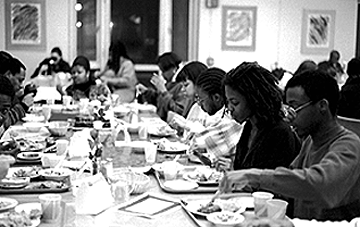








Lord-Saunders's location on the southwest corner of campus separates it from many other dorms and buildings at the College. This separation quickly dissolves, however, upon entering the building and being surrounded by the welcoming residents, who call their home "The House."
The colorful murals and other art that adorn Afrikan Heritage House (AHH) reflect the Houses' theme. This theme - Africa - provides The House with a strong purpose. Associate Professor of African-American Studies Booker Peek said that AHH is meant to be "a source of inspiration for black Americans."
The House has a history of promoting pride in students with an African heritage since its foundation in 1969. Peek characterized Oberlin in 1969 as a "campus secure with itself to try new things." Student requests for such a house in a time of national attention to issues of civil rights and social injustices motivated Oberlin to allocate a space in Talcott Hall for housing males with an interest in African heritage. Soon after, a female counterpart to this was established in Baldwin Cottage.

More changes occurred in 1972, when the house moved to its present location in Lord-Saunders. During these early years, the ratio of African-Americans to white students in the House was 2:1.
Although AHH presently houses a small number of non-African-American students, it is "a mecca for all peoples, ... one of the most hospitable places on campus," Peek said.
Despite its hospitality, segregation on campus has been an area of concern surrounding the House from its establishment through the present day. "[The House] is another form of segregation ... that needs to be justified periodically," Peek said.
Concern about segregation stimulates a lot of dialogue among House residents. College first-year and House resident, Belice Cabrera said, "[The House] is not a hate house, it's a unification house ... [that offers] a way to be at home with all the brothers and sisters around us ...and to learn about our African culture."
Ginneh Flamer, a college first-year and House resident said, "The House does segregate, but not bad segregation." Flamer recently moved to AHH, and said she now feels "uncomfortable with white students."
Zachery Pride, another first-year resident, said, "[The House] is very good. At other schools, you lose your identity."
The comfort of a home is evident in the calmness and caring of the interactions between the residents in AHH. During the course of an afternoon, residents pass through the foyer, and friendly "Hey, what's up?" greetings prompt many conversations. By the end of the afternoon, the room is full of people, openly greeting and talking with one another.
"Activism is perceived as militancy, cold. [Our activism] puts shadows on us," said Joy Williams, junior resident coordinator in The House. Despite the reputation associated with The House, according to Williams, "It's a very serious, yet very warm place."
In response to people who question AHH's values, Williams said, "I feel like people who try to cast negativity on The House don't understand and aren't listening. They have closed eyes and closed ears. Just listen to people and come to The House."
Meals mixed with culture: Students dine at Afrikan Heritage House. (photo by Tanner Mullen)

Copyright © 1996, The Oberlin Review.
Volume 124, Number 15; February 23, 1996
Contact Review webmaster with suggestions or comments at ocreview@www.oberlin.edu.
Contact Review editorial staff at oreview@oberlin.edu.